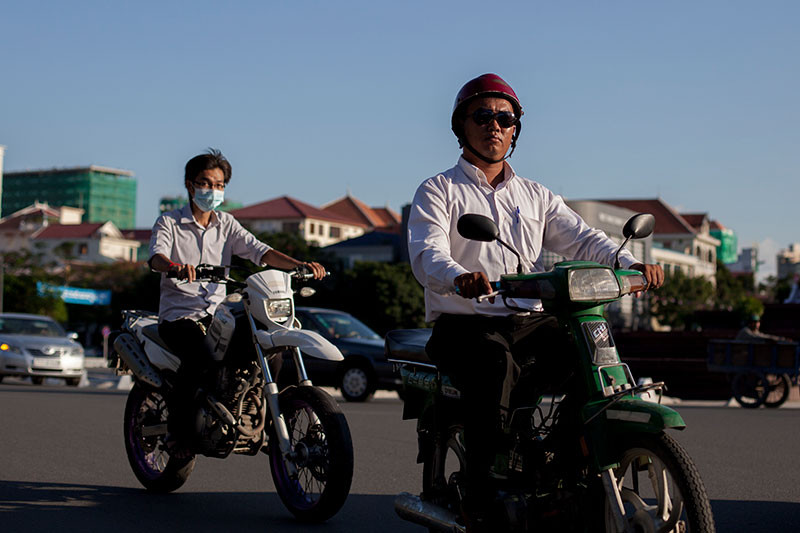Pon Lichantha was heading home from a market in Kompong Speu province with her mother and father when the rear tire of the Honda Dream they were riding on exploded, sending the family flying off the motorbike and onto the road.
Ms. Lichantha, 28, was most seriously injured, hitting her head on the ground and falling unconscious. Following a head scan at Calmette Hospital in Phnom Penh, doctors discovered she had a blood clot in her brain that would need to be removed surgically. She remained unconscious for a week and the treatment cost her family about $3,000.

The housewife doesn’t know if the $10 helmet she was wearing helped her or not.
“I was wearing a helmet, but the chin strap was not strong,” she said. “When the motorbike got a flat tire, my head hit the ground and I was unconscious. I cannot remember whether the helmet was still on my head or fell off.”
Beginning on January 1, when the country’s new traffic law comes into force, all motorbike drivers and passengers above the age of 3 will be required to wear a helmet, and police will issue a 15,000 riel (about $3.75) fine per violation.
The aim is to reduce fatalities from traffic accidents, which the World Health Organization says are among the leading causes of death in the country. Six people died per day on the country’s roads last year, with motorbike drivers and passengers accounting for 73 percent of all traffic deaths.
However, simply wearing a helmet is not enough, experts say. Motorists have to be wearing helmets that will actually protect them.
“Wearing a helmet that’s not certified or up to standard is like not wearing a helmet at all,” said Ear Chariya, a freelance road safety consultant.
A lack of government enforcement mechanisms to regulate the quality of helmets on the market in Cambodia makes efforts to put a helmet on every head potentially futile, Mr. Chariya said.
Even if helmet use increases, the number of people who sustain head injuries will also increase if people are wearing substandard helmets, which introduce their own complications, he added.
In the event of a collision, a low quality helmet not only fails to provide protection, but pieces of the helmet can splinter off and cause additional injury, said Steve Morrish, managing director of risk management firm SMCS Group.
“For helmets that cover the face or ears—if they are not safety rated or have some standards they can reduce vision and hearing which is very important when riding on the road,” he said in an email.
But the message has not reached most people, Mr. Morrish said.
“Currently in Cambodia, the vast majority of motorcycle riders would be buying a helmet based on price and not on any safety standards or ratings,” he said.
According to the latest research into the helmets on sale in Cambodia, the chances of buying a safe helmet aren’t good. A 2008 study by Dynamic Research found that just one out of 12 helmets in the country passed all testing criteria for helmet safety set by the Global Road Safety Partnership.
In 2010, the Institute of Standards of Cambodia approved a directive that regulates basic build- quality standards for motorbike helmets. It also describes extensive testing a helmet must pass in order to be considered fit for Cambodian consumers.
But there has been no implementation, according to Pagna Kim, country director of the Asia Injury Prevention Fund.
“We don’t have the testing lab in order to prove or ensure that the helmets on the market meet the standard that we develop,” he said.
The construction of a helmet-testing lab would cost $500,000 to $700,000, depending on the quality of the lab, Mr. Kim said, adding that while construction plans for the lab already existed, there was no funding for it.
Men Chansokol, deputy director of the Transport Ministry’s land transport department, said the government and several NGOs submitted a proposal to the Asian Develop- ment Bank (ADB), requesting near- ly $1 million to fund the construction of a testing lab about a year ago.
However, the ADB instead chose to fund a road construction project, Ms. Chansokol said. And while there are ongoing discussions about submitting a new proposal next year, there is no guarantee that donors will come forward with funding, she added.
Eang Huoy, 62, has operated a helmet shop on Monireth Boulevard in Phnom Penh for about five years. She carries a wide variety of helmets, from Napoli helmets from Vietnam, which go for $5, to new Paulo models with a chin protector, which she gets from Thailand and sells for $40.
Ms. Houy, however, said she was not even aware that helmet safety standards existed in Cambodia.
“When the company comes to give me the helmets, they tell me it’s good quality because when it falls to the ground, it doesn’t break,” she said.